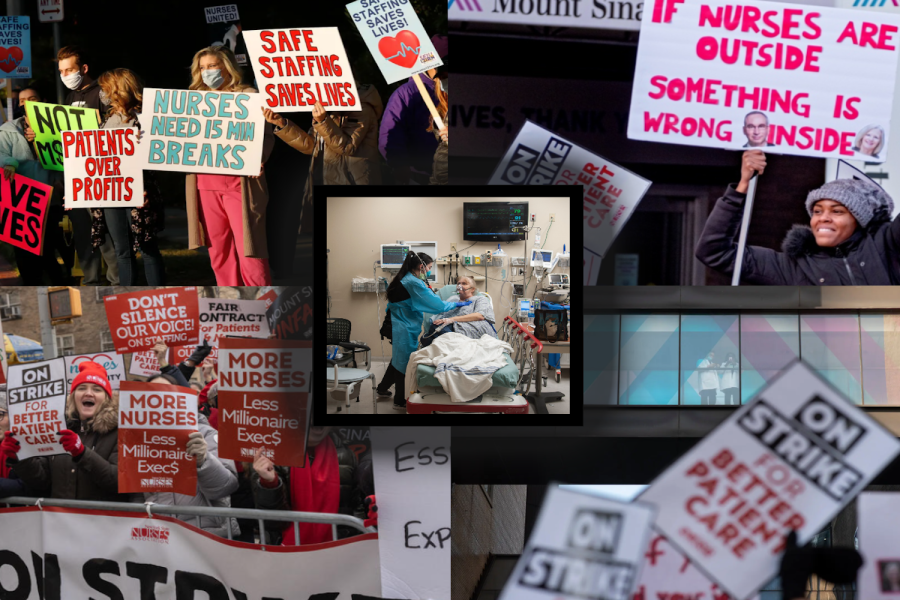Diagnosing the nursing shortage in the United States
Nurses across the country protest unsafe working conditions caused by the nursing shortage.
Throughout 2020, Americans applauded nurses for their selfless work during COVID-19. Banners on hospital signs and roadways hailed healthcare workers as “heroes.” However, starting January 4, nurses across the United States (US) have come together to ask for support. Over 7,000 nurses united outside of Mount Sinai Hospital in New York City and Montefiore Medical Center in the Bronx, New York in protest of unsafe working conditions January 10, according to npr.org. Since the coronavirus pandemic, a spike in the nursing shortage has affected healthcare workers around the globe. While nurses are protesting for better contracts, they are also advocating for their patients who are not receiving quality care due to low staffing levels in hospitals. Ms. Catherine Considine ’13, a nurse at the Children’s Hospital of Philadelphia (CHOP), described the changes she has experienced while working during the shortage.
The demographics of nurses are the cause of the nursing shortage. Over 50 percent of nurses are older than 50 years old, according to nursejournal.org. Within the next decade, the healthcare industry expects a large number of nurses will retire, increasing the demand for nurses in healthcare. Additionally, nurses have demonstrated a heightened interest in changing professions due to stress and burnout caused by the coronavirus pandemic, according to aacnnursing.org. Despite the 155,000 individuals who graduate as Registered Nurses each year, there will not be enough nurses to fulfill the shortage, according to healthaffairs.org.

While the nursing shortage continues to pose a threat to healthcare, acceptance rates in nursing schools remain competitive. In 2021, 76,140 qualified applicants did not receive enrollment into entry-level bachelor’s nursing programs, according to aacnnursing.org. As nursing requires hands-on learning, programs must maintain a small faculty-to-student ratio, causing nursing school admissions to be competitive.
Nurses in the US have expressed their concerns by participating in strikes. Nurses from Mount Sinai Hospital and Montefiore Medical Center in New York City went on strike to raise awareness about the unsafe working conditions in their units. The nursing shortage has caused hospitals to be short-staffed, creating more work for nurses without improving their contracts, according to cnn.com.
The nursing shortage not only affects nurses but also patients. Ms. Considine is a nurse at the third-best pediatric hospital in the world, according to newsweek.com. After graduating from the College of Nursing at Villanova University, she began working in the oncology unit at CHOP. She discussed how she has seen the nursing shortage affect her patients and coworkers.

“Normally on my floor, we are one nurse for every two patients, and I would say that over the past three years or so, starting with COVID, the ratio definitely shifted to one to three,” Ms. Considine said. “The age of nurses right now is just so young, so especially at a hospital like CHOP, the age of nurses is much lower than it previously was. It’s overwhelming to become a new nurse regardless but to come into a hospital as a new nurse and there are these staffing crises that are making you have to work harder because you have an additional patient that in a normal world you wouldn’t necessarily have.”
Ms. Considine explained that nurses do not spend much time sitting down. She described the physical elements of her job and how further stress can poorly impact nurses.
“It is a very physical job in the sense that you’re on your feet all the time, you’re moving from patient room to patient room frequently,” Ms. Considine said. “I think in an average day, even in the one hallway that I work in, you walk four miles every day just by going up to blood bank, coming back downstairs, going to scans, coming back over. So, it’s a very physically exhausting job and I think adding on the additional stress of not having as many staff members has just made it a more mentally draining job.”
Featured Image by Lindsay Benza ’23

Lindsay is delighted to serve as one of the the Editors-in-Chief for the King Street Chronicle during the 2022-2023 academic year. She is eager to collaborate...


